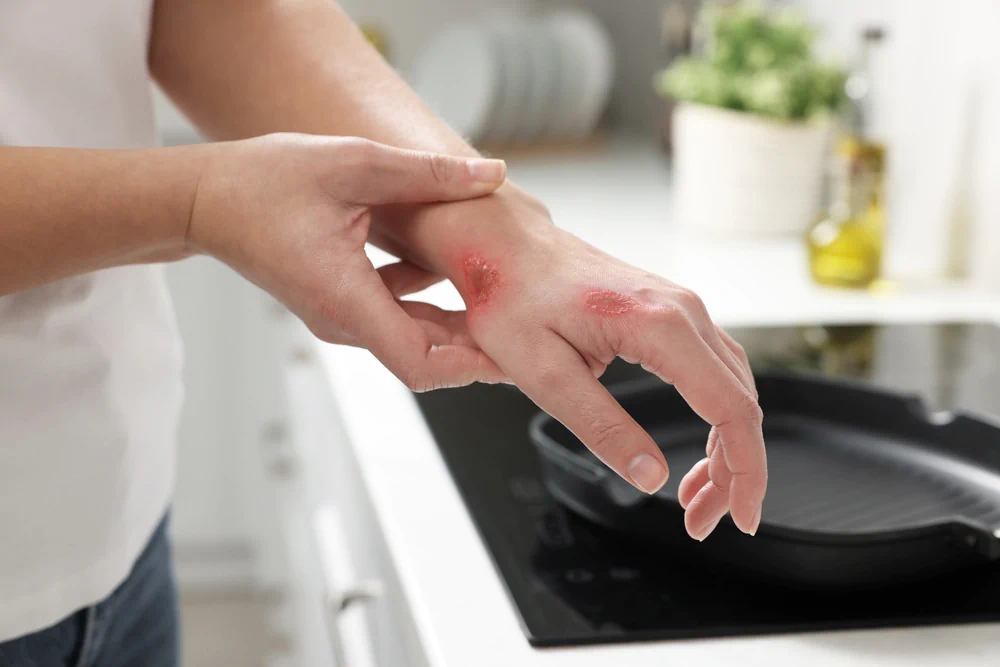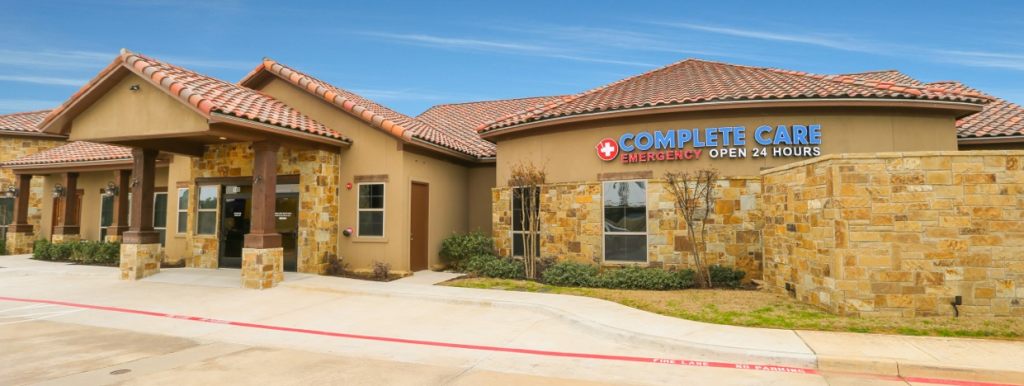
Burns are a common household injury that can range from mild to severe. When a burn damages the skin enough to cause fluid to collect beneath the surface, a blister forms — a natural protective response that helps shield the damaged skin underneath. While minor burn blisters can often be treated at home, knowing the proper care techniques is essential for promoting healing and preventing infection.
Your burn blister care routine should include:
- Gently clean the area with mild soap and cool water
- Apply an antibiotic ointment to prevent infection
- Cover with a sterile, non-stick bandage
- Change dressings regularly
- Avoid popping the blister
- Take over-the-counter pain relievers as needed
If your burn is large, deep, or involves sensitive areas like your face, hands, or genitals, don’t hesitate to seek professional care. Complete Care’s freestanding ER locations offer 24/7 access to medical professionals who specialize in treating burns of all severities.
For life-threatening situations, please call 911.
How to care for a burn blister
Proper burn blister care requires attention to detail and a gentle approach to avoid further injury. When treating a second-degree burn that has blistered, following these specific steps will promote healing and reduce the risk of complications.
Gently clean the area with mild soap and cool water
The first step in taking care of a blister burn is getting it properly cleaned. Hold the affected area under cool (not cold) running water for about 10-15 minutes to reduce pain and swelling. Then, using a mild, fragrance-free soap, gently wash around the blister without applying pressure. This removes potential contaminants that could lead to infection while preserving the blister’s protective covering. For oil burns this initial cleaning is particularly important, to remove any residual substances that could irritate the wound.
Apply an antibiotic ointment to prevent infection
Once the area is clean and dry, applying a thin layer of antibiotic ointment creates a protective barrier against bacteria. This step is important for preventing infection, which can delay healing and potentially lead to complications like a treatment for abscess becoming necessary. For burns from outdoor activities like barbecuing — one of the common grilling injuries during summer months — antibiotic ointment is especially important, as these burns may have more environmental contaminants. Use a clean cotton swab rather than your fingers to apply the ointment to maintain sterility.
Cover with a sterile, non-stick bandage
Properly covering the burn is essential for both protection and healing. Use a sterile, non-stick gauze or specialized burn dressing that won’t adhere to the damaged skin. The covering should be loose enough to avoid pressure on the blister but secure enough to stay in place. For larger burns, consider specialized burn pads that provide additional padding and protection. This barrier is particularly important for those who are extremely sunburnt, as it shields the sensitive skin from further damage and irritation while allowing it to breathe and heal.
Change dressings regularly
Maintaining a clean environment around your burn is crucial for proper healing. Change your dressings at least once daily or more frequently if they become wet or soiled. When removing old bandages, work slowly and gently to avoid disrupting the blister. If the dressing sticks, soak it in warm water to loosen the adhesive. Fresh dressings keep the area clean and provide an opportunity to monitor the burn blister healing stages, which typically progress from fluid-filled to gradually flattening as new skin forms underneath.
Avoid popping the blister
Though it may be tempting, resist the urge to pop or drain a burn blister. The fluid-filled sac serves as a natural barrier against infection and creates the optimal environment for new skin to form underneath. Puncturing this protective covering increases infection risk and may lead to scarring or delayed healing. If a blister breaks on its own, don’t remove the overlying skin — it continues to provide protection. Instead, clean the area gently and cover it with a sterile bandage to prevent contamination.
Take over-the-counter pain relievers as needed
Managing discomfort is an important aspect of burn recovery. Over-the-counter pain relievers like ibuprofen or acetaminophen can help reduce both pain and inflammation. Follow package directions for proper dosing, and consider timing your medication to provide relief during dressing changes, which can temporarily increase discomfort. For more severe burns that cause significant pain despite medication, consult a healthcare provider at Complete Care for additional pain management strategies that won’t interfere with the healing process.
When to go to the ER for burn blister care
While many burn blisters can be effectively treated at home, certain situations require immediate medical attention. If you’re unsure about the severity of your burn, notice concerning symptoms, or are wondering when to go to the ER for burns, it’s always better to err on the side of caution and seek professional care. Particularly for:
- A second-degree burn that covers a large area (larger than 3 inches in diameter)
- Burns on the face, hands, feet, genitals, buttocks, or over major joints
- Signs of infection, such as increasing redness, swelling, warmth, or red streaking from the burn site
- Pus drainage or increased pain after initial improvement
- Fever over 100.4°F (38°C)
- Burns caused by chemicals, electricity, or radiation, even if they initially appear minor
- Burns that affect breathing (such as those from inhaling smoke or hot air)
- Burns that create a full-thickness injury (charred or white appearance)
- Burns in vulnerable populations such as infants, elderly, or those with compromised immune systems
How to care for a burn injury before heading to the ER
Knowing how to care for a burn injury at home is important, but recognizing when professional care is needed can prevent long-term complications. At Complete Care’s freestanding emergency rooms, you’ll receive prompt evaluation and treatment from specialists trained in burn care, without the typical long waits associated with hospital emergency departments.
Before heading to any of our freestanding ERs:
- Remove any jewelry or clothing that can come into contact with the burn
- However, do not try to remove clothing that is stuck in the burn
- Run the burn under cool (NOT cold) water for about 10 minutes
- Dry the skin and cover it with a loose and light cloth
Trust Complete Care for quick and effective burn treatment with low wait times
Proper burn blister care requires both attention to detail at home and knowing when to seek professional help. While minor burns can often be safely managed with the steps outlined in this guide, more serious injuries deserve expert medical attention. Complete Care’s freestanding emergency rooms offer specialized burn treatment with shorter wait times and comprehensive care options that traditional ERs may not provide.
With locations throughout Austin, Corpus Christi, Dallas/Fort Worth, East Texas, Lubbock, San Antonio, and Colorado Springs, Complete Care ensures you have access to emergency burn treatment no matter where you are. Our medical professionals are equipped with advanced treatment options and the expertise to address burns of all severity levels, helping to minimize pain, prevent infection, and reduce scarring.
When it comes to burn injuries, timely and appropriate care makes all the difference in your recovery journey. Don’t hesitate to visit your nearest Complete Care location when you need professional burn blister care.
More Helpful Articles by Complete Care:
- What Causes Shortness of Breath?
- How to Prevent Trampoline Injuries
- When to Go to the ER for Pneumonia Treatment
- Working With a Loved One Through Denial of Medical Treatment
- What Does Cellulitis Look Like on the Leg?
